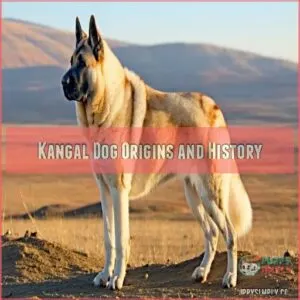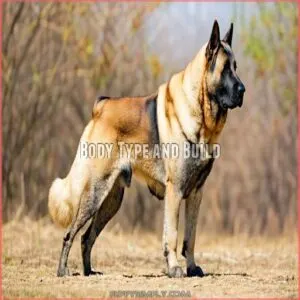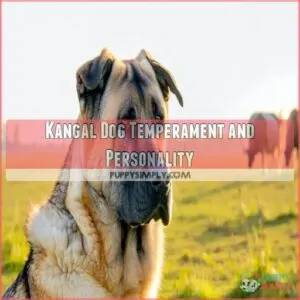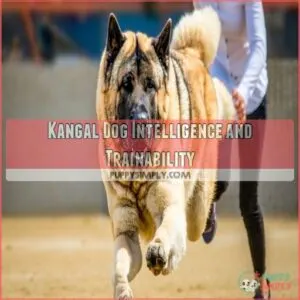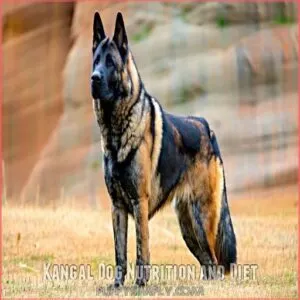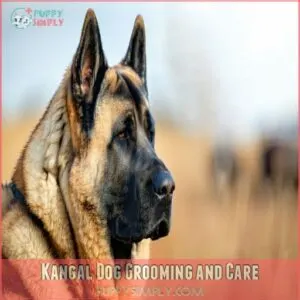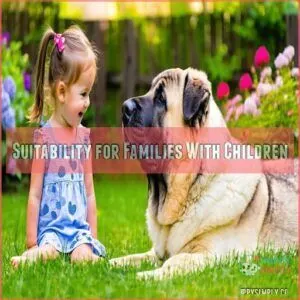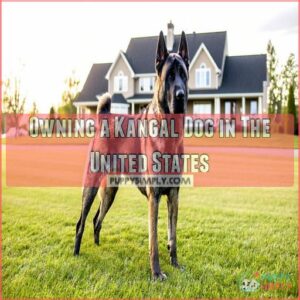This site is supported by our readers. We may earn a commission, at no cost to you, if you purchase through links.
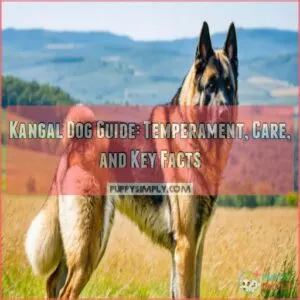
Towering up to 31 inches tall and weighing as much as 150 pounds, these majestic guardians sport a thick, fawn-colored coat and a distinctive black mask.
Their temperament is both calm and protective, making them exceptional family companions—though their independent spirit might challenge your training skills.
With a lifespan of 12 to 15 years, they’re robust yet need care for possible health issues like hip dysplasia.
Intrigued by this gentle giant’s power? There’s more to explore about their compelling nature.
Table Of Contents
- Key Takeaways
- Kangal Dog Origins and History
- Kangal Dog Size and Appearance
- Kangal Dog Temperament and Personality
- Kangal Dog Intelligence and Trainability
- Kangal Dog Health and Lifespan
- Kangal Dog Nutrition and Diet
- Kangal Dog Grooming and Care
- Kangal Dog Exercise and Activity Needs
- Kangal Dog as a Family Pet
- Owning a Kangal Dog in The United States
- Frequently Asked Questions (FAQs)
- Can you own a kangal in the United States?
- Are kangal dogs aggressive?
- Is a kangal a good family dog?
- What is it like to own a Turkish kangal dog?
- Is the kangal the most powerful dog?
- Is a Kangal illegal in the US?
- Is Kangal the strongest dog in the world?
- Are Kangals aggressive to other dogs?
- Is Kangal stronger than a lion?
- Is a Kangal dog a good pet?
- Conclusion
Key Takeaways
- You’ll find Kangals to be powerful guardian dogs, weighing up to 150 pounds and standing 31 inches tall, with a distinctive fawn-colored coat and black mask, making them easily recognizable.
- You need to commit to consistent training and early socialization, as their independent nature and strong protective instincts require an experienced owner’s guidance to become well-adjusted family companions.
- You must provide at least 1-2 hours of daily exercise and ample space for your Kangal, as these dogs aren’t suited for apartment living and require both physical activity and mental stimulation to stay healthy.
- You can expect your Kangal to live 12-15 years, but you’ll need to monitor them for common health issues like hip dysplasia and bloat, while maintaining a proper diet of 4-7 cups of high-quality kibble daily.
Kangal Dog Origins and History
You’ll discover the Kangal’s history is deeply rooted in the nomadic Turkish tribes, where these magnificent dogs served as loyal protectors of flocks for centuries.
Their incredible heritage continued, even playing a significant role in pre-World War II sheepdog projects, solidifying their reputation as exceptional working dogs.
Kangal’s history and its role as a protector are highlighted.
Nomadic Turks and Flock Guardian Roots
The Kangal dog‘s rich history traces back to ancient Turkic tribes’ nomadic lifestyles.
This breed isn’t just any dog; it’s a Turkish Kangal, born for livestock protection.
With a heritage deeply rooted in Turkey, you can find various merchandise and resources related to Kangal dog history items.
Imagine roaming vast Anatolian plains, its instincts finely honed to guard sheep.
As one of the quintessential livestock guardian dogs, Kangals embody strength and loyalty, balancing power with gentleness.
Early Role in Sheepdog Projects
Imagine this: during pre-war programs, the Kangal dog‘s early role in sheepdog projects was pivotal.
These Turkish Kangal dogs became essential in WWII impact studies, with their breed selection and herding techniques making a mark.
In this setting, they were:
- Valued for protection
- Essential in livestock guardian roles
- Masters of adaptation
- Resilient project outcomes.
Kangal Dog Size and Appearance
When you first meet a Kangal Dog, you’ll notice its impressive size, with males standing up to 31 inches tall and weighing up to 150 pounds.
These gentle giants sport a dense, fawn or sable coat that perfectly complements their strong, muscular build and distinctive black mask.
Weight and Height Characteristics
Imagine standing next to a Turkish Kangal and feeling its impressive size.
Males typically tower at around 29 inches, weighing 110-150 lbs.
Females gracefully balance at 80-120 lbs and stand roughly 27 inches tall.
These proportions make Kangals giants among canines, their size a perfect match for their protective nature.
Ever wondered how your height measures up?
Coat and Color Variations
Kangal dogs boast a short, dense double coat that’s perfect for insulation.
Their typical fawn shades and sable variations add a touch of elegance, accompanied by distinctive black masks.
Occasionally, you’ll spot rare markings that make them unique.
These pure Turkish Kangals reflect their rugged heritage, capturing their essence in countless Kangal dog pictures, highlighting their majestic appearance and rich color genetics.
Body Type and Build
With their muscular structure and impressive bone density, Kangal dogs are powerhouses wrapped in fawn coats. Their overall size makes them imposing yet graceful guardians.
- Broad chest gives stability
- Strong legs offer agility
- Balanced body proportions blend power with elegance
These features make them legendary protectors, known for their exceptional Kangal dog breed traits.
Kangal Dog Temperament and Personality
You’ll find Kangals are incredibly loyal family companions.
Their protective instincts are legendary – they’re fiercely devoted guardians, so understanding their temperament is key to a happy, harmonious home life.
Their calm demeanor belies a powerful protective nature, making them excellent livestock guardians but requiring responsible ownership.
Livestock Guardian Instincts
Born with instincts that run deep, the Kangal dog’s protective behaviors are a true demonstration of its role as a livestock guardian.
With a high prey drive and natural territoriality, these Turkish Kangals excel in sheep protection.
However, training challenges can arise due to their independent guarding styles.
Knowledge of these traits helps guarantee effective management and harmony on the farm.
Family Companions and Loyalty
Imagine sharing your space with a giant furball that’s loyal to the bone.
These dogs aren’t just livestock guardians; they’re incredible family companions too.
Kangals thrive in family life, creating a safe environment for kids and pets.
Their natural instincts as protective and loyal companions make them suitable for homes with:
- Children
- Other pets
- Active families
Calm Yet Protective Nature
Kangals, with their strong owner bond, balance calmness with fierce protective instincts. They’re like watchful guardians, always ready yet steady.
Curious about their guarding style?
Check out the table below for insights:
| Trait | Description |
|---|---|
| Reaction to Strangers | Cautious, alert, evaluating |
| Territorial Behavior | Marked boundaries, protective |
| Family Loyalty | Deep owner connections, vigilant |
| Protective Instinct | High, guarantees safety |
Kangal Dog Intelligence and Trainability
Kangal Dogs impress with their intelligence, making them both trainable and challenging for first-time owners.
You’ll need consistent training and early socialization to turn their natural instincts into reliable behavior.
Early Socialization and Positive Reinforcement
Picture yourself as a pup parent guiding your Kangal dog through puppy classes.
Early socialization is key to realizing their loyal potential.
Use a reward system to build positive habits and tackle challenges. Kangal dog temperament shines when they’re exposed to diverse experiences.
With patience, you’ll master dog training, celebrating each new skill as a triumph in kangal dog socialization. dog training
Firm Training Approach and Consistency
Start fostering that early socialization with positive reinforcement as your go-to.
When handling aggression or dealing with dominance in your Kangal, think of yourself as the consistent anchor.
You need to maintain a firm training approach daily, like a steady rhythm in music, controlling the pace. This consistency solidifies their temperament, reflecting true kangal shepherd dog trainability.
Mental Stimulation and Exercise Needs
Consistency’s key; now let’s free your Kangal’s inner genius! A bored Kangal is a mischievous Kangal. Mental workouts are just as important as physical ones. Think of it like this: you wouldn’t just lift weights; you’d also train your brain, right?
- Daily walks aren’t just for exercise; they’re social time!
- Enrichment activities, like puzzle toys, keep minds sharp.
- Training games boost confidence and bond you two closer.
Kangal Dog Health and Lifespan
When taking care of a Kangal dog, you’re getting more than just a fluffy friend;
you’re tackling some serious health concerns. They can live 12-15 years but keep an eye out for bloat, hip dysplasia, and hypothyroidism to guarantee a healthy life.
Common Health Issues and Concerns
Watching your Kangal thrive requires awareness of potential health bumps like allergies and thyroid issues.
These gentle giants aren’t immune to genetic quirks, so consider genetic testing.
Managing allergies involves diet tweaks and regular vet check-ups.
By staying proactive, you’ll help prolong their impressive lifespan, ensuring your loyal guardian remains by your side, ready to tackle life’s adventures.
Bloat, Hip Dysplasia, and Hypothyroidism
Kangal dogs aren’t just about strong jaws; they’re prone to bloat, hip dysplasia, and hypothyroidism.
While hip dysplasia shares some similarities with elbow dysplasia in dogs, early detection is essential.
Your best ally? Regular vet visits and genetic testing.
Treatment options can vary, and long-term management is key.
Want prevention strategies? Keep an eye on their diet and maintain proper exercise.
Tackle kangal dog health problems before they start!
Average Lifespan and Care Expectations
Understanding Kangal life involves more than addressing potential health problems like bloat, hip dysplasia, or hypothyroidism.
With a lifespan stretching 12 to 15 years, you’ve got a loyal but demanding companion.
Your daily routine, from grooming to exercises, becomes a dance of devotion.
Keep in mind, owning one means committing to mid-range care costs, ensuring a vibrant, happy life for your Kangal.
Kangal Dog Nutrition and Diet
Feeding your Kangal dog isn’t just about filling the bowl—it’s about crafting a balanced diet that caters to their active lifestyle.
With Kangal dogs needing up to 4-7 cups of high-quality kibble daily, you’ll guarantee they thrive with proper nutrition fitted to their size and energy levels.
Daily Food Intake and Feeding Schedule
Crafting a healthy diet for your Kangal dog means understanding its unique needs.
Feeding frequency typically includes two hearty meals a day. Adjust the food bowl size to prevent overfeeding.
Puppies require more frequent meals than adults.
Keep your Kangal hydrated with plenty of water and consider adding dietary supplements as they mature, enhancing overall Kangal dog nutrition.
Dry Food and Kibble Recommendations
So, you’ve got your daily food amounts figured out.
Now, let’s talk kibble! Choosing the right dog food is like picking the perfect adventure buddy – it’s gotta be a good fit.
Look for high-quality kibble brands with clear ingredient analysis. Pay attention to portion sizes based on your dog’s weight. Remember, allergies are a thing, so watch for those too.
Finding the best kibble for your furry friend is a journey, but it’s worth it!
Nutritional Needs and Considerations
When feeding a Kangal dog, you’ll want to focus on balanced nutrition that suits their unique needs, much like Bulldogs who require a high-protein diet with 22% protein for puppies and 18% for adults from animal sources like a dog’s best diet.
- Dietary restrictions: Always watch for food allergies.
- Water intake: Make certain there’s always fresh water available.
- Supplemental vitamins: Consult your vet for advice.
- Obesity prevention: Stick to portion control; Kangals thrive on structured meals.
Kangal Dog Grooming and Care
Caring for a Kangal Dog’s coat involves weekly brushing to manage shedding, along with occasional baths to keep them looking sharp.
Don’t forget regular nail trimming.
ear cleaning, and teeth brushing to guarantee your pup stays healthy and comfortable.
Weekly Brushing and Coat Maintenance
Kangal grooming needs start with regular brushing to manage that dense double coat, utilizing tools such as a bamboo pet metal pin brush.
Nailing down the right brushing techniques reduces shedding season chaos and keeps mats at bay.
For best results, use quality grooming tools that suit your Kangal’s coat types.
Kangal dog care gets easier when you embrace this calming routine, boosting both tidiness and companionship.
Occasional Bathing and Nail Trimming
After ensuring a smooth and well-brushed coat, shift focus to bathing your Kangal.
They typically need a bath every couple of months unless they’ve had a particular adventure in the mud.
For a suitable cleaning solution, consider using a kangal dog shampoo.
Keep their nails trimmed using clippers to prevent discomfort.
Regular paw care is key to maintaining your Kangal dog’s happiness and hygiene, aligning with their grooming schedule.
Ear Cleaning and Teeth Brushing
Don’t forget that ear cleaning tools and dental health are just as important as a good bath for your Kangal dog.
Aim to brush teeth weekly and use dental chews to keep their smiles bright.
Home remedies can help, but vet advice is golden for kangal dog care.
Keep those ears clean to maintain excellent Kangal dog health.
Kangal Dog Exercise and Activity Needs
You’ll find that keeping a Kangal happy means committing to at least 1-2 hours of exercise each day.
Despite being gentle giants, these dogs need space to roam and plenty of mental challenges to stay fit and sharp.
Daily Exercise Requirements and Recommendations
Keeping your Kangal healthy means understanding their exercise needs. A well-exercised Kangal is a happy Kangal.
Their size influences their exercise needs, and considering factors like breed-specific exercise requirements and individual health conditions is essential when deciding how often do you walk your dog.
Here’s what you need to know:
- Adult Kangals need at least an hour a day, maybe more.
- Puppies need shorter, more frequent sessions.
- Older dogs need gentler exercise.
- Daily walks are a must.
- Fetch? They’ll love it!
Physical Activity and Mental Stimulation
Your Kangal dog thrives when daily exercise needs are adequately met.
Mental enrichment is just as important. Playtime ideas like puzzle toys and training games ignite their intelligence and keep them on their toes. Think of it as a brain gym for your furry friend, ensuring they stay sharp and happy.
Here’s a guide:
| Activity | Duration | Benefits |
|---|---|---|
| Walks | 1 Hour | Physical health |
| Puzzle Toys | 30 Min | Mental enrichment |
| Fetch | 15 Min | Coordination |
| Tug-of-War | 20 Min | Strength building |
| Training Games | 30 Min | Obedience training |
Space and Living Condition Considerations
Thinking about a Kangal’s space needs can feel like organizing a mini football field. This breed thrives with:
- Yard size: Large spaces let them roam free.
- Fencing needs: A secure, high fence keeps them safe.
- Climate impact: They’re adaptable but prefer cooler climates.
- Housing type: Rural settings suit their guarding instincts.
- Average size: With their size, at least 25-30 inches tall, urban apartments just won’t cut it.
Kangal Dog as a Family Pet
When you welcome a Kangal Dog into your family, you’re gaining a gentle giant who’s both a loyal watchdog and a playful companion.
With proper socialization and early training, Kangals fit nicely into family life, even with children and other pets.
Suitability for Families With Children
A Kangal’s guardian spirit makes it a strong contender for families with kids.
Known for its protective instincts, this giant Turkish dog blends well with family dynamics.
Early socialization and effective training methods are key to channeling its loyalty and might into safe, kid-friendly behavior.
Are Kangals good family dogs? Absolutely, with patience and understanding of their unique temperament.
Compatibility With Other Pets and Animals
Wondering how Kangals mix with other pets? Their protective nature can be a double-edged sword.
They may see unfamiliar animals as threats unless introduced gradually.
A giant Turkish Kangal’s temperament tends to be more accepting over time, reflecting their guardian roots.
Successful integration involves patience and clear boundaries, ensuring peace at home.
Socialization and Training for Family Life
When getting a Kangal, early socialization is your secret weapon against future behavior issues. Puppy classes lay the groundwork for smooth family integration.
Positive reinforcement techniques during crate training at home can also help reduce separation anxiety and make them more confident around family members.
Adult training sharpens their strong personality traits.
Thinking if Kangal dogs are nice? They sure can be!
| Task | Timing | Benefit |
|---|---|---|
| Puppy Classes | Early life | Reduces issues |
| Family Time | Ongoing | Integration |
| Adult Training | Post-puppy | Temperament |
| Playtime | Daily | Social Skills |
Owning a Kangal Dog in The United States
Bringing a Kangal into your home requires understanding US regulations regarding ownership and finding reputable breeders or rescue organizations.
Factor in the significant costs associated with providing proper food, veterinary care, and a safe environment for this large, powerful breed.
Legality and Registration Considerations
Understanding dog laws can sometimes feel like a maze, especially with breed restrictions circling Turkish Kangals.
In the U.S., legality varies by state or city—some areas even label them as potentially dangerous.
Check local registration bodies for requirements and licensing fees.
Insurance implications also play a role, so examine policy details to avoid surprises.
Breeders and Rescue Organizations
Finding reputable breeders for Kangal dogs is key to guaranteeing healthy puppies.
Seek out those practicing ethical breeding with health testing protocols.
Consider adopting through rescue organizations too, although the process can present challenges.
Engaging with experts helps you navigate buying a Kangal.
Remember, whether it’s breeders or rescues, guarantee they’re committed to the breed’s wellbeing.
Cost and Care Expectations for Ownership
Thinking of bringing a Kangal dog into your life?
Consider the investment—initial purchase from breeders ranges from $1,500 to $4,000. Add food costs, vet bills, and training expenses. Insurance can cushion unexpected hits, but they all add up.
Owning this noble breed means you’re embracing loyalty and protection, as well as the necessary commitment to its care.
Frequently Asked Questions (FAQs)
Can you own a kangal in the United States?
Back in ye olden days, owning a Kangal wasn’t easy. Today, you can! But, responsible ownership’s key—check local laws first. They’re powerful dogs needing experienced owners.
Are kangal dogs aggressive?
Kangals aren’t inherently aggressive but can become protective when defending their territory or family.
Their loyalty and strong protective instincts make them effective guard dogs.
Proper socialization and training are key to managing their naturally protective nature.
Is a kangal a good family dog?
Sure, why not bring a gentle giant into the family?
Despite their formidable size and strength, Kangals are surprisingly loving and loyal.
With early socialization, they become protective companions, perfect for families with spacious backyards.
What is it like to own a Turkish kangal dog?
Owning a Turkish Kangal feels like having a gentle giant with a fierce protective streak.
You’ll enjoy their loyalty and calm demeanor.
But be ready for daily exercise and early training to harness their impressive guarding instincts.
Is the kangal the most powerful dog?
With a bite force of 743 psi, Kangals hold a reputation as incredibly powerful dogs.
Though not the absolute strongest in every aspect, their unmatched guarding instinct and physical prowess make them formidable protectors and impressive companions.
Is a Kangal illegal in the US?
Kangals aren’t illegal across the U.S.
But local bans or restrictions might apply, often due to breed-specific legislation seen in certain states or cities.
Always check your local laws before bringing one into your area.
Is Kangal the strongest dog in the world?
Imagine this powerhouse: Kangals hold the title for strongest bite force among dogs, with an impressive 743 psi.
They protect fiercely due to their strength and history as livestock guardians in Turkey.
Despite drama, they’re gentle protectors.
Are Kangals aggressive to other dogs?
Their protective instincts mean they can be wary of other dogs. Early socialization is key; proper training helps them be good canine citizens. It’s all about raising a well-adjusted pup.
Is Kangal stronger than a lion?
Imagine David facing Goliath; it’s intriguing to ponder whether a Kangal matches a lion’s strength.
While a Kangal has a powerful bite and agility, it’s not stronger than a lion in size and ferocity.
Is a Kangal dog a good pet?
Kangals can make excellent pets for experienced owners with large yards and active lifestyles.
You’ll need time for training, socialization, and daily exercise.
They’re loyal guardians but aren’t suited for apartment living.
Conclusion
Like a diamond in the rough, the Kangal dog shines as a remarkable companion for the right owner.
Their unique blend of gentle strength and unwavering loyalty makes them exceptional guardians and family members.
While they require dedicated training, proper socialization, and space to thrive, the rewards of raising a Kangal dog are immeasurable.
If you’re ready for a devoted partner with ancient wisdom and modern adaptability, this majestic breed might just be your perfect match.

